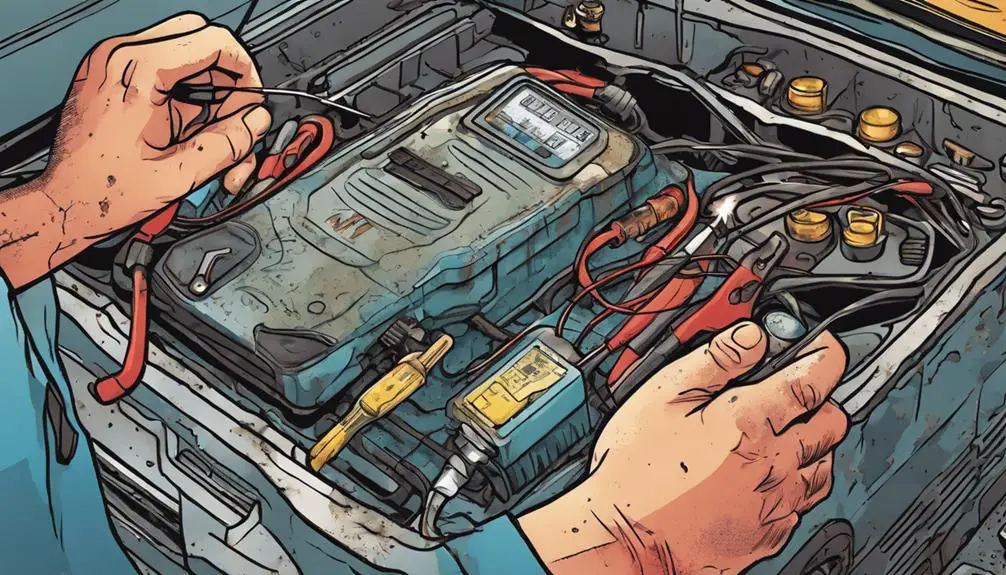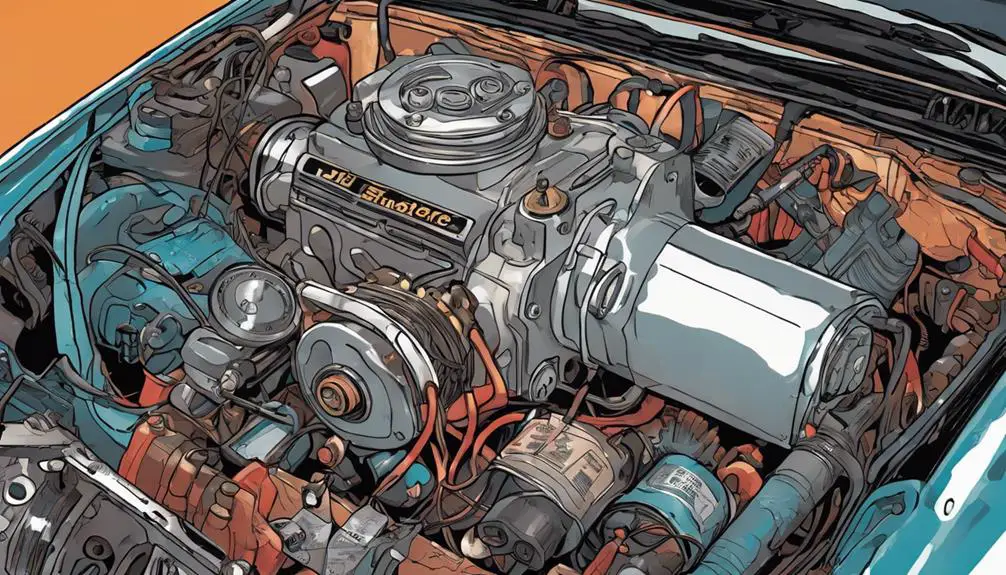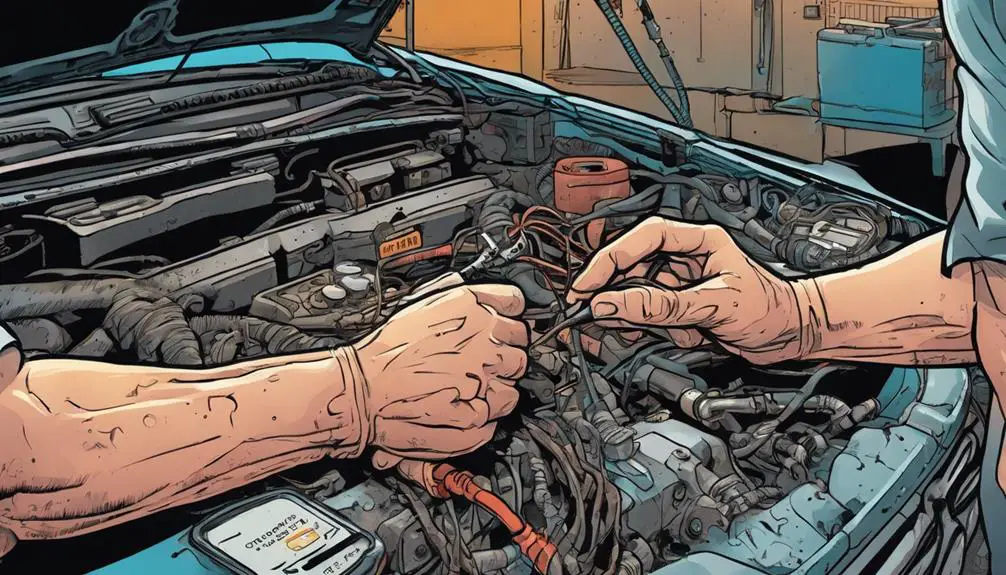Many people overlook the importance of battery condition in preventing intruder starting issues, but it's often the first line of defense. You might be surprised at how a simple battery check can save you from frustrating delays. There are several other critical factors that contribute to these problems, and knowing them can make all the difference in maintaining your system's reliability. To guarantee you're fully prepared, let's explore five essential tips that can help you address and prevent these starting issues effectively.
Quick Takeaways
- Check the battery levels in alarms and cameras; replace weak batteries immediately to ensure reliable operation.
- Inspect the starter motor for wear and corrosion; replace it if damaged to maintain performance.
- Test the ignition system by listening for unusual sounds and checking dashboard lights for consistent illumination.
- Review electrical connections for corrosion and loose wires; clean and tighten connections as needed.
Check the Battery Condition

One of the first things you should do is check the battery condition of your security devices. A strong, reliable battery is your first line of defense against intruders. If your alarms, cameras, or motion sensors are running low, they can fail when you need them most. So, take a moment to inspect each device — it's a simple task that carries significant weight in protecting your freedom.
Start by testing the batteries in your alarms and surveillance systems. Replace any weak or dead batteries immediately. Don't just assume they're good; even new batteries can fail. Make it a habit to check these regularly, ideally every few months, to guarantee they're always ready to spring into action.
You can also consider investing in rechargeable batteries or solar-powered devices for more sustainable options. This not only helps the environment but also guarantees your security is always at the forefront.
Inspect the Fuel System
Inspecting the fuel system of your security devices is essential to confirm they're functioning at their best and ready to protect your home. When you want peace of mind, you need to ascertain that every part of your system is in top shape.
Start by checking the fuel lines for any leaks or damage. Even a small crack can lead to serious issues, compromising your device's performance.
Next, look at the fuel filter. A clogged filter can restrict flow, making it difficult for your device to operate efficiently. If it appears dirty or hasn't been replaced in a while, go ahead and swap it for a new one.
Don't forget to check the fuel itself. It should be clean and free from contaminants. Old or contaminated fuel can lead to starting issues, so consider draining the system if it hasn't been used for an extended period.
Lastly, confirm that all connections are tight and secure. Loose connections can lead to fuel loss and affect overall performance.
Examine the Starter Motor

After confirming your fuel system is in good shape, it's important to check the starter motor to guarantee your security devices will activate when needed. The starter motor plays a vital role in initiating your system, so you'll want to inspect it thoroughly.
Start by locating the starter motor, usually found near the engine or within the vehicle's frame. Once you've identified it, look for any signs of wear, such as frayed wires or corrosion. If you notice any damage, it's advisable to replace the motor to assure ideal performance.
Next, check the connections. Loose or corroded terminals can impede the flow of electricity, causing your security devices to fail when you need them most. Tighten any loose connections and clean off corrosion with a wire brush.
Test the Ignition System
Testing the ignition system guarantees that your vehicle's security devices respond effectively when activated. To verify your ride is secure and ready, start by turning the key in the ignition. If you hear a clicking sound but the engine doesn't turn over, that's your first clue something's off.
Next, take a moment to listen for any unusual noises when attempting to start. A smooth, quiet start is a sign of a healthy ignition system. If you notice grinding sounds or intermittent starts, it's time to dig deeper.
You should also check the dashboard lights. If they flicker or don't illuminate at all, it could signal an underlying issue. A fully functioning ignition system means those lights should glow consistently, indicating all systems are go.
Review Electrical Connections

To guarantee your vehicle's security system functions properly, check the electrical connections for any signs of wear or corrosion. These connections are vital; they power your system and keep your vehicle secure.
Start by inspecting the battery terminals. If you spot any corrosion, clean them with a wire brush and a mixture of baking soda and water. This simple step can greatly improve the conductivity.
Next, trace the wiring harnesses connected to the alarm system. Look for frayed wires or loose connections. If you find any, it's important to repair or replace them to prevent potential starting issues.
Don't forget to check the fuses related to your security system. A blown fuse can leave you vulnerable, so replace any that are faulty.
Lastly, consider using a multimeter to test voltage at various points, ensuring everything is functioning within recommended parameters. Regularly reviewing your electrical connections empowers you to maintain your vehicle's integrity.
Common Questions
What Are Common Signs of a Failing Fuel Pump?
When a fuel pump's failing, you might notice some telltale signs.
If your engine sputters or struggles to start, that's a big red flag. You may also experience a loss of power while driving, especially during acceleration.
Listen for whining or buzzing sounds from the fuel tank, which can indicate trouble.
How Often Should I Replace My Battery?
You should replace your battery every three to five years, but it really depends on your driving habits and climate.
If you live in extreme temperatures, it might wear out faster.
Picture your car struggling to start on a cold morning—that's a battery on its last legs.
Regularly checking your battery's health can liberate you from unexpected breakdowns, allowing you to enjoy the freedom of the road without worries.
Stay proactive!
Can Extreme Weather Affect Starting Issues?
Extreme weather can definitely affect your bike's starting issues. When temperatures drop, your battery's efficiency can decrease, making it harder to start.
Similarly, excessive heat can strain components and lead to potential failures.
You'll want to make certain your bike's well-maintained and properly stored during these conditions.
Keeping your battery charged and checking the electrical connections can help you stay ready to ride, no matter the weather.
Don't let the elements hold you back!
What Tools Do I Need for These Inspections?
You'll need a few essential tools for effective inspections. Did you know that 80% of engine troubles stem from simple maintenance issues?
Grab a multimeter to check electrical connections, a compression tester for engine health, and basic hand tools like wrenches and screwdrivers.
A flashlight will help you see into those tight spots.
With the right equipment, you can take charge of your vehicle's performance and guarantee it runs smoothly when you need it most.
Are There Specific Warning Lights for Starting Problems?
Yes, there are specific warning lights that can indicate starting problems in your vehicle.
If you see a battery light, it might mean your battery's weak or the charging system's failing.
A check engine light could signal various issues, including fuel or ignition problems.
Pay attention to these signals; they're your vehicle's way of communicating with you.
Don't ignore them—addressing the issue promptly can save you time and money down the road.
Wrapping Up
By following these five tips, you can effectively tackle intruder starting issues and guarantee your system runs smoothly.
Did you know that about 70% of starting problems can be traced back to battery issues? Regularly checking your battery condition could save you a lot of frustration and time.
With consistent maintenance on your fuel system, starter motor, ignition system, and electrical connections, you'll greatly reduce the chances of encountering problems when you need your system most.